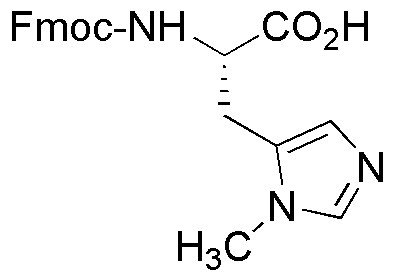Fmoc-His(3-Me)-OH is widely utilized in research focused on:
- Peptide Synthesis: This compound serves as a protective group in solid-phase peptide synthesis, allowing for the selective addition of amino acids while preventing unwanted reactions.
- Drug Development: Its role in modifying peptide structures can enhance the bioactivity and stability of therapeutic peptides, making it valuable in pharmaceutical research.
- Bioconjugation: Fmoc-His(3-Me)-OH is used to create conjugates with biomolecules, facilitating targeted drug delivery systems in cancer therapy.
- Protein Engineering: Researchers utilize this compound to introduce specific histidine residues in proteins, which can improve their binding properties and catalytic activities.
- Analytical Chemistry: It aids in the development of analytical methods for detecting and quantifying peptides, contributing to advancements in proteomics.
General Information
Properties
Safety and Regulations
Applications
Fmoc-His(3-Me)-OH is widely utilized in research focused on:
- Peptide Synthesis: This compound serves as a protective group in solid-phase peptide synthesis, allowing for the selective addition of amino acids while preventing unwanted reactions.
- Drug Development: Its role in modifying peptide structures can enhance the bioactivity and stability of therapeutic peptides, making it valuable in pharmaceutical research.
- Bioconjugation: Fmoc-His(3-Me)-OH is used to create conjugates with biomolecules, facilitating targeted drug delivery systems in cancer therapy.
- Protein Engineering: Researchers utilize this compound to introduce specific histidine residues in proteins, which can improve their binding properties and catalytic activities.
- Analytical Chemistry: It aids in the development of analytical methods for detecting and quantifying peptides, contributing to advancements in proteomics.
Documents
Safety Data Sheets (SDS)
The SDS provides comprehensive safety information on handling, storage, and disposal of the product.
Product Specification (PS)
The PS provides a comprehensive breakdown of the product’s properties, including chemical composition, physical state, purity, and storage requirements. It also details acceptable quality ranges and the product's intended applications.
Certificates of Analysis (COA)
Search for Certificates of Analysis (COA) by entering the products Lot Number. Lot and Batch Numbers can be found on a product’s label following the words ‘Lot’ or ‘Batch’.
Numéro de catalogue
Numéro de lot/série
Certificates Of Origin (COO)
This COO confirms the country where the product was manufactured, and also details the materials and components used in it and whether it is derived from natural, synthetic, or other specific sources. This certificate may be required for customs, trade, and regulatory compliance.
Numéro de catalogue
Numéro de lot/série
Safety Data Sheets (SDS)
The SDS provides comprehensive safety information on handling, storage, and disposal of the product.
DownloadProduct Specification (PS)
The PS provides a comprehensive breakdown of the product’s properties, including chemical composition, physical state, purity, and storage requirements. It also details acceptable quality ranges and the product's intended applications.
DownloadCertificates of Analysis (COA)
Search for Certificates of Analysis (COA) by entering the products Lot Number. Lot and Batch Numbers can be found on a product’s label following the words ‘Lot’ or ‘Batch’.
Numéro de catalogue
Numéro de lot/série
Certificates Of Origin (COO)
This COO confirms the country where the product was manufactured, and also details the materials and components used in it and whether it is derived from natural, synthetic, or other specific sources. This certificate may be required for customs, trade, and regulatory compliance.


